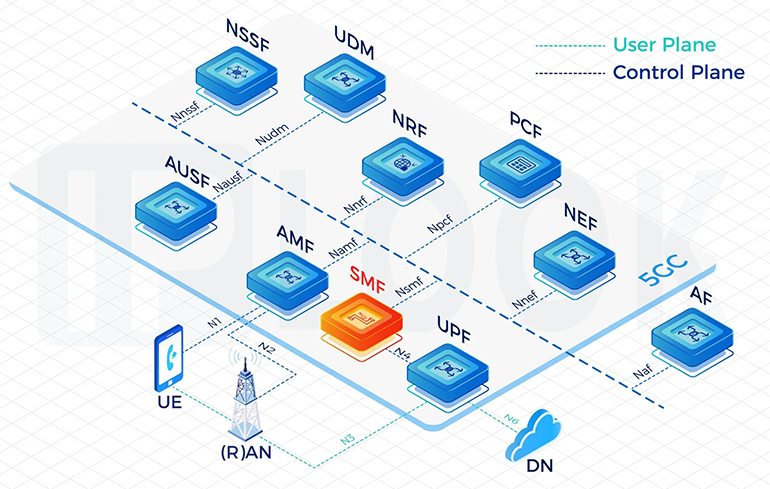
Imagine the 5G network as a futuristic superhighway. Speed limits are sky-high, lanes are multi-dimensional, and traffic flows in every direction. But to truly unlock this potential, it takes more than wide lanes — it requires a real-time command center directing every movement. Enter the Session Management Function (SMF).
What Does the SMF Actually Do?
The SMF isn’t just another 5G component. It’s the central control engine of the 5G Core (5GC), orchestrating dynamic, intelligent connectivity at scale.
1. Smart Session Lifecycle Management
The SMF manages the full lifecycle of data sessions — from initiating connections when needed (like flipping on a light), to modifying session parameters on the fly, and efficiently releasing resources when sessions end. This ensures optimal resource utilization and network performance.
2. Dynamic IP Address Allocation
Every device in the network needs a unique identifier. The SMF automatically assigns IP addresses to user equipment (UE), ensuring devices connect smoothly and securely to network services and the internet.
3. Real-Time Policy Enforcement
Working closely with the Policy Control Function (PCF), the SMF enforces network policies and prioritizes traffic. For example, a video call might get low-latency, high-priority routing, while an app update is handled with standard service — all based on predefined quality-of-service rules.
Inside the SMF Workflow: From Tap to Data Transfer
When you open an app on your smartphone, here’s what happens behind the scenes:
Request Initiation: Your phone sends a connection request.
Access Coordination: The AMF (Access and Mobility Management Function) receives it and forwards it to the SMF.
Session Control: The SMF springs into action — assigning an IP, selecting the best User Plane Function (UPF), and configuring traffic routes.
Data Path Setup: The SMF coordinates with the AMF, UPF, and others to build the complete end-to-end data path.
Continuous Optimization: As you move, switch cells, or close the app, the SMF dynamically adjusts paths or releases resources, maintaining seamless performance.
Why SMF Is Critical to 5G Success
Dynamic Resource Management
SMF enables real-time, demand-driven allocation of network resources — ensuring each service gets exactly what it needs, when it needs it.
System-Wide Intelligence
Deep integration with AMF, PCF, and UPF allows the network to behave like a coordinated, responsive organism — adapting to user behavior in real time.
Network Slicing Made Real
SMF is key to building and managing custom network slices — virtual sub-networks with specific performance characteristics (e.g., ultra-low-latency for surgery, high throughput for stadiums).
Operational Agility
It empowers operators to launch and scale new services rapidly, customizing network behavior for diverse enterprise or consumer needs.
Real-World Applications: SMF in Action
The SMF isn’t just theoretical — it’s already powering transformative innovations:
Smart Manufacturing: Establishes dedicated, secure channels for precision machine control and industrial automation.
XR & Mission-Critical Services: Supports ultra-low latency and high bandwidth for immersive VR, AR, and remote surgical procedures.
Connected Vehicles: Ensures uninterrupted, high-speed connectivity for autonomous and V2X-enabled transportation.
Tailored Network Services: Enables operators to deliver differentiated experiences — from premium VPNs to tiered QoS offerings.
The Session Management Function (SMF) is more than a traffic manager — it's the invisible conductor behind the intelligent, flexible, and user-centric performance that defines true 5G. From seamless mobility to custom slices, SMF ensures that every packet of data flows precisely where and how it should.
What aspects of 5G are you most curious about?
Learn more on YouTube:
SMF P1: https://youtu.be/0Eowpv20Fbc?si=DhEW1MWckhBHkVqA
SMF P2: https://youtu.be/os-gwIj_azc?si=-bOyxyDwUJG5bv4l
SMF P3: https://youtu.be/UoB8Ckhem-U?si=8Y83ijcHctImE99Y

